Related Research Articles

Tirana is the capital and largest city of Albania. It is located in the centre of the country, enclosed by mountains and hills with Dajti rising to the east and a slight valley to the northwest overlooking the Adriatic Sea in the distance. It is among the wettest and sunniest cities in Europe, with 2,544 hours of sun per year.

Sulejman Pasha Bargjini was an ethnic Albanian general, nobleman and Governor of the Ottoman Empire. He was originally from Bargjin, but he settled in the village of Mullet, Albania and probably served as a Janissary, he was given the title Pasha. As an ethnic Albanian, he had fought for the Ottomans against the Safavids in Persia. After that he had built a mosque, a bakery and a hammam. He founded the settlement of Tirana, now the capital of Albania, in 1614 as an oriental-style town of those times. According to some local legends, he named the town he founded after Tehran, the capital of Persia. This, however, is a folk etymology without basis in fact, as Tirana was already mentioned in Venetian documents as early as 1418.
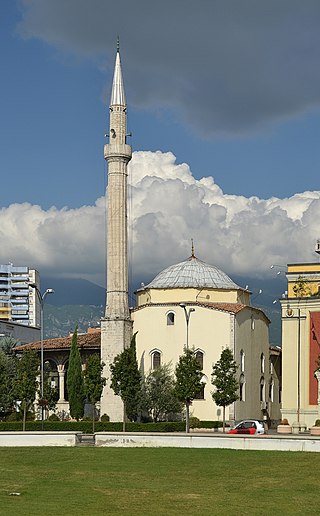
The Et'hem Bey Mosque is a mosque in Tirana, Albania. Closed under communist rule, the mosque reopened as a house of worship in 1991. Without permission from the authorities, 10,000 people attended and the police did not interfere. Frescoes outside and in the portico depict trees, waterfalls and bridges.
Vithkuq is a village and a former municipality in the Korçë County, southeastern Albania. At the 2015 local government reform it became a subdivision of the municipality Korçë. The population at the 2011 census was 1,519. The municipal unit consists of the villages Vithkuq, Leshnje, Gjanc, Lubonjë, Rehovë, Roshanj, Trebickë, Grabockë, Treskë, Stratobërdh, Panarit, Shtyllë and Cemericë.

The Abdurrahman Pasha Mosque, also known as the Clock Mosque and historically as the Old Peqin Mosque is a Cultural Monument of Albania, located in Peqin.
The Albanian revolts of 1833–1839 took place in Albania as a reaction against the new centralizing policy of Ottoman administration.

Independent Albania was a parliamentary state declared in Vlorë on 28 November 1912 during the First Balkan War. Its assembly was constituted on the same day while its government and senate were established on 5 December 1912.
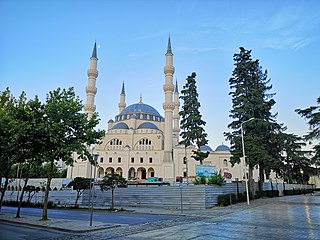
The Great Mosque of Tirana or Namazgah Mosque is a mosque which is currently being built in Tirana, Albania. When completed, it will be the largest mosque in the Balkans.

The architecture of Albania is a reflection of Albania's historical and cultural heritage. The country's architecture was influenced by its location within the Mediterranean Basin and progressed over the course of history as it was once inhabited by numerous civilisations including the Illyrians, Ancient Greeks, Romans, Byzantines, Venetians, Ottomans as well as modern Austro-Hungarians and Italians. In addition, missionaries, invaders, colonisers and traders brought cultural changes that had a large profound effect on building styles as well as techniques.
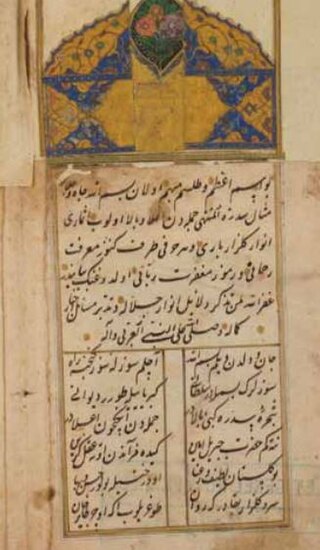
Yahya bey Dukagjini was an Albanian poet and military figure. He is known for his Ottoman Turkish diwan poems of the 16th century.

Haxhi Ymer Kashari known also as Ymer Mustafa Kashari was an Albanian bejtexhi of the 18th century.

Haxhi Et'hem Bey also known as Haxhi Et'hem bey Mollaj (1783–1846) was an Ottoman Albanian administrator, nobleman and bejtexhi.
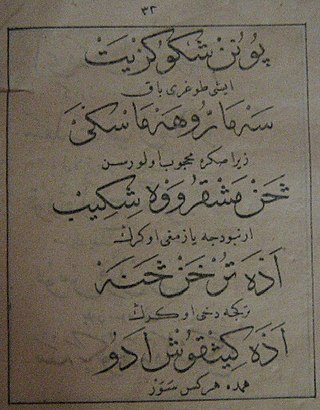
Mulla Daut Efendi Boriçi (Turkish: Davut Şükrü Efendi,, was an Albanian scholar, müderris and nationalist figure of the Albanian National Awakening. For most of his life he was involved in the Ottoman educational system and is remembered for his Albanian primer in the Arabic alphabet of 1861, and his leadership during the League of Prizren.
Zenel Bastari or Zenel Hyka was an Albanian poet of the Bejtexhinj literary movement. A native of Tirana, he lived and worked from the end of 18th century until mid 19th century. Together with Hasan Zyko Kamberi and Nezim Frakulla he was part of the Bejtexhinj who focused on social and political criticism rather than Islamic moral and life. A precursor of the bourgeois critical-realism, he is also considered one of the first anti-feudal writers in Albania.
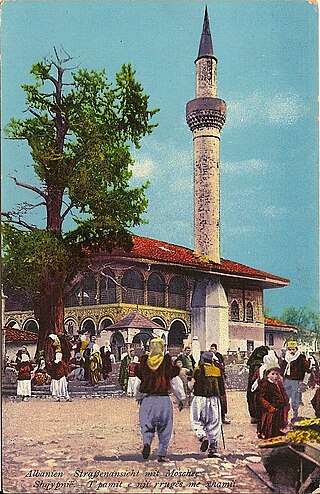
The Old Mosque or Sulejman Pasha mosque was the founding mosque of the Albanian capital Tirana. The city developed around the mosque, which was founded by the Ottoman Albanian Pasha Sulejman Bargjini along with a hammam and a bakery. In the mid of the 20th century, all of it was razed to make place for the Communist-era Unknown Soldier statue.
The Vrioni were an aristocratic Albanian family and one of the largest landowners of Albania, otherwise known as "Konaqe" or "Oxhaqe", among which the most important are: Vrioni of Berat and Fier, Vloraj of Vlora, Toptani of Tirana, Biçakçinjtë of Elbasan, Dino of Ioannina and Preveza, Vërlaci of Elbasan, Bushatllinjtë of Shkodra, Këlcyrajt of Këlcyra, Markagjonët of Mirdita, etc. Insignia titles held by members of these families, usually Pasha or Bey, corresponded to the assigned positions in the Ottoman administration, central or local, which are given by ferman or berat (decrees) by the Sultan of the Ottoman Empire.
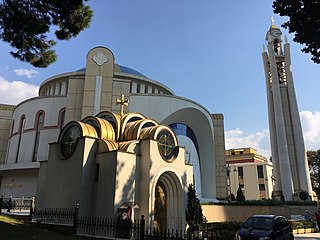
There are many landmarks in Tirana, Albania some of which are of considerable historical or artistic interest. Many monuments and landmarks situated in Tirana, date back to the Illyrian, Roman, Greek and Ottoman periods.
The Taksim meeting alternatively known as the Taksim Plot and less commonly as the Taksim Assembly was a secret meeting held in January 1912 by Albanian nationalist deputies of the Ottoman parliament and other prominent Albanian political figures. The event gets its name from Taksim Square because of the location of the house where it was held. The meeting was organized on the initiative of Hasan Prishtina and Ismail Qemali, Albanian politicians, who invited most of the MPs of Albanian origin and aimed at launching an armed general uprising in Albanian territories against the central government headed by the Committee of Union and Progress (CUP). The meeting followed two other Albanian uprisings of 1910 in the Vilayet of Kosovo and 1911 in the mountains of upper Shkodra. The Taksim meeting resulted in an uprising the same year, with armed uprisings in Shkodër, Lezhë, Mirditë, Krujë and other Albanian provinces, which exceeded the organizers' expectations. The biggest uprising was in Kosovo, where the rebels were more organized and managed to take over important cities like Prizren, Peja, Gjakova, Mitrovica and others.

The Sanjak of Durrës, also known in the west by the Italian form as the Sanjak of Durazzo, was one of the sanjaks of the Ottoman Empire. It was named after its county town Durrës. The sanjak was composed of the kazas of Durrës, Tirana, Shijak, Kavajë, and Krujë. The Sanjak of Durrës was located in the southern part of the Vilayet of Scutari and was one of its two constituent sanjaks. It bordered to the north the Sanjak of Scutari, Manastir and Dibra to the north-east, Elbasan to the east and south, and the Adriatic Sea to the west. Its terrain is generally flat and plain, and only the eastern parts of the kazas of Tirana and Kavajë are mountainous.
References
- 1 2 3 4 H.T.Norris (1993), Islam in the Balkans: Religion and Society Between Europe and the Arab World, University of South Carolina Press, pp. 77–78, ISBN 9780872499775, OCLC 28067651
- 1 2 Türk Arşivciler Derneği (2007), Arşiv dünyası, Istanbul, p. 86, OCLC 464762117
{{citation}}: CS1 maint: location missing publisher (link)